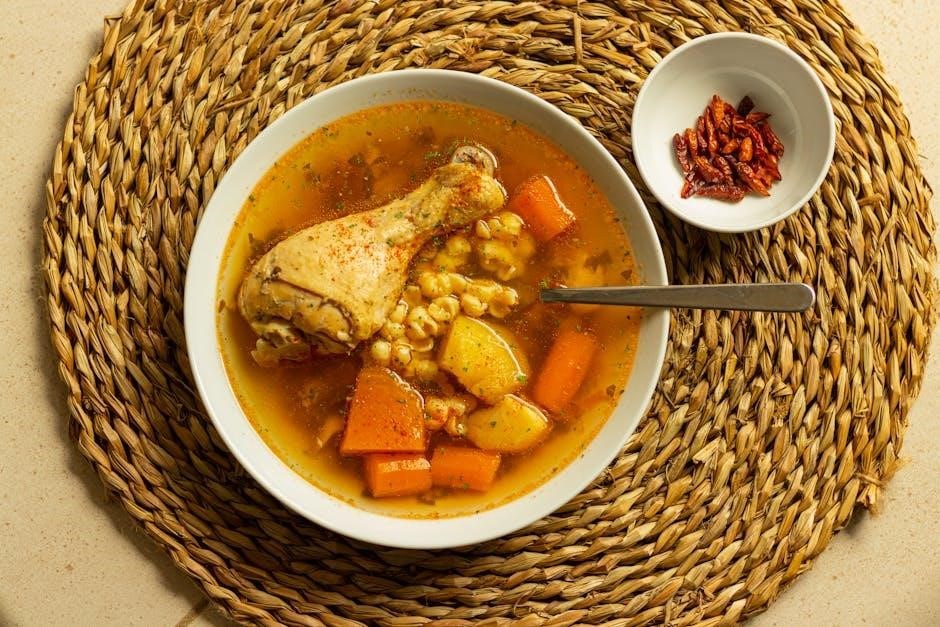Discover the essential list of vegetables in Spanish through detailed PDF guides, offering interactive content to learn names, pronunciation, and cultural significance in Spanish cuisine.
Overview of Vegetables in Spanish Cuisine
Vegetables play a vital role in Spanish cuisine, contributing to its rich flavors and nutritional balance. Spanish cooking often highlights fresh, seasonal produce, with a wide variety of vegetables featured in traditional dishes. From leafy greens like espinacas (spinach) and lechuga (lettuce) to root vegetables such as zanahorias (carrots) and patatas (potatoes), the diversity of vegetables in Spain is remarkable. Many PDF guides list these vegetables, providing names, images, and cultural context, making them accessible for learners. These resources also emphasize the importance of locally sourced and seasonal vegetables, which are central to the Mediterranean diet. By exploring these guides, one can gain insight into how vegetables are prepared in Spanish recipes, from soups and salads to stews and tapas. This approach not only celebrates culinary tradition but also promotes healthy eating habits.
Importance of Learning Vegetable Names in Spanish
Learning the names of vegetables in Spanish is essential for effective communication in culinary and cultural contexts. Whether shopping at markets, cooking traditional dishes, or engaging with Spanish-speaking communities, knowing these terms enhances your ability to navigate everyday situations. PDF guides provide comprehensive lists of vegetables, often accompanied by images and pronunciation tips, making them invaluable tools for learners. Understanding vegetable names also deepens your appreciation of Spanish cuisine and its emphasis on fresh, seasonal ingredients. Moreover, it supports language acquisition by expanding vocabulary and fostering confidence in using Spanish in practical scenarios. These resources are particularly useful for travelers, food enthusiasts, and language learners seeking to immerse themselves in the rich cultural and gastronomic traditions of Spanish-speaking countries.
Structure of the Article

Classification of Vegetables
Vegetables in Spanish are categorized into types like leafy greens, root vegetables, cruciferous, allium, and nightshade. Examples include spinach, broccoli, garlic, and tomatoes, each with unique characteristics and uses in cuisine.
Leafy Green Vegetables in Spanish
Leafy green vegetables, known as verduras de hoja verde, are a cornerstone in Spanish cuisine. Common examples include spinach (espinacas), lettuce (lechuga), kale (col rizada), and Swiss chard (acelga). These vegetables are rich in essential vitamins like A, C, and K, as well as minerals such as calcium and iron. They are widely used in salads, soups, and sautéed dishes, making them a versatile choice for both traditional and modern recipes. PDF guides often highlight these greens, providing their Spanish names, nutritional benefits, and cultural significance. Learning their names is crucial for navigating Spanish markets and cookbooks. Incorporating leafy greens into meals aligns with the Mediterranean diet’s emphasis on fresh, seasonal ingredients, promoting a healthy and flavorful lifestyle. They are also celebrated for their versatility in various culinary preparations.
Root Vegetables in Spanish
Root vegetables, or verduras de raíz, are a fundamental part of Spanish cuisine. Common examples include carrots (zanahorias), beets (remolachas), potatoes (patatas), sweet potatoes (batatas), and turnips (nabos). These vegetables are valued for their versatility and nutritional benefits, being rich in vitamins, minerals, and dietary fiber. They are often used in stews, soups, and roasted dishes, and are a key component of traditional Spanish meals like cocido and tortilla de patatas. PDF guides frequently include these root vegetables, providing their Spanish names, pronunciation, and cultural significance. Learning their names is essential for understanding Spanish recipes and grocery shopping. Root vegetables are celebrated for their hearty flavor and adaptability in both traditional and modern cooking, making them a staple in many Spanish-speaking countries. Their importance is highlighted in various culinary resources, ensuring they remain central to Spanish gastronomy.
Cruciferous Vegetables in Spanish
Cruciferous vegetables, known as verduras crucíferas in Spanish, include broccoli (brócoli), cauliflower (coliflor), cabbage (col), and kale (col rizada). These vegetables are rich in vitamins, antioxidants, and fiber, making them highly nutritious. They are widely used in Spanish cuisine, appearing in dishes like soups, salads, and stir-fries. PDF guides often list these vegetables, providing their names, pronunciation, and nutritional benefits. Learning their Spanish names is essential for cooking traditional meals and understanding local recipes. Cruciferous vegetables are also highlighted for their health benefits, such as reducing inflammation and boosting immunity. They are a staple in many Spanish-speaking countries and are celebrated for their versatility and flavor. These vegetables are a key part of a balanced diet, making them a focus in culinary education and health resources. Their importance is well-documented in Spanish-language PDF guides.
Allium Vegetables in Spanish
Allium vegetables, or verduras del género Allium, include garlic (ajo), onion (cebolla), shallots (chálotes), and chives (cebollín). These are fundamental in Spanish cuisine, adding flavor to dishes like paella, stews, and salads. PDF guides often list these vegetables, providing their names, pronunciation, and culinary uses. Garlic and onions are staples in Spanish cooking, used in sauces and as bases for soups. Shallots and chives are less common but still valued for their unique flavors. These vegetables are also recognized for their health benefits, such as reducing cholesterol and improving heart health. Learning their Spanish names is essential for mastering traditional recipes. PDF resources highlight their importance in Mediterranean diets and offer visual aids for identification. These vegetables are versatile and indispensable in Spanish-speaking kitchens. Their cultural and nutritional significance is well-documented in Spanish-language guides.
Nightshade Vegetables in Spanish
Nightshade vegetables, or verduras de la familia Solanaceae, are widely used in Spanish cuisine. Common examples include tomatoes (tomates), peppers (pimientos), and eggplants (berenjenas). These vegetables are rich in vitamins A and C, potassium, and antioxidants. PDF guides often list these vegetables, highlighting their nutritional benefits and culinary applications. Tomatoes are a cornerstone in Spanish dishes like gazpacho, while peppers add flavor to paella. Eggplants are often used in stir-fries and tapas. These vegetables are versatile and feature prominently in Mediterranean diets. Learning their Spanish names is crucial for exploring traditional recipes; PDF resources also provide visual aids and pronunciation guides, making it easier to identify and cook with these vegetables. They are not only delicious but also offer significant health benefits, making them a staple in Spanish-speaking kitchens. Their cultural and nutritional importance is well-documented in Spanish-language guides.
Nutritional Benefits of Vegetables
Spanish vegetables provide essential vitamins, minerals, and antioxidants, promoting overall health. They are rich in dietary fiber, supporting digestion and heart health, as highlighted in PDF guides.
Vitamins and Minerals in Spanish Vegetables
Spanish vegetables are a rich source of essential vitamins and minerals. Leafy greens like spinach and kale are high in iron and calcium, while bell peppers and oranges provide vitamin C. Root vegetables such as carrots are packed with vitamin A, and potatoes are a good source of potassium. Cruciferous vegetables like broccoli contain vitamin K and folate, supporting heart health. Tomatoes and eggplants, part of the nightshade family, offer vitamin C and antioxidants. These nutrients help maintain immune function, energy levels, and overall well-being. PDF guides list these vegetables, highlighting their specific vitamin and mineral content, making it easier to incorporate them into a balanced diet. Learning their names in Spanish enhances understanding of their nutritional value in Mediterranean cuisine.
Antioxidants in Spanish Vegetables
Spanish vegetables are packed with antioxidants, essential for combating free radicals and promoting overall health. Vegetables like pimientos (bell peppers) and berenjena (eggplant) are rich in antioxidants that help protect against chronic diseases. Tomates (tomatoes) contain lycopene, a powerful antioxidant, while leafy greens such as espinacas (spinach) and lechuga (lettuce) offer a variety of antioxidant compounds. Cruciferous vegetables like brócoli (broccoli) are high in glucosinolates, which support detoxification processes. These antioxidants not only enhance the flavor of Spanish dishes but also contribute to a healthier diet. PDF guides provide detailed lists of these vegetables, making it easier to identify and incorporate them into meals. Understanding their names and properties in Spanish enhances appreciation for their nutritional benefits in Mediterranean cuisine.
Dietary Fiber in Spanish Vegetables
Spanish vegetables are an excellent source of dietary fiber, essential for maintaining healthy digestion and overall well-being. Vegetables such as alcachofas (artichokes), guisantes (peas), and zanahorias (carrots) are particularly high in fiber, promoting regular bowel movements and satiety. Leafy greens like espinacas (spinach) and lechuga (lettuce) also contribute significantly to daily fiber intake. Root vegetables, such as cebolla (onions) and remolacha (beets), are rich in soluble and insoluble fiber, supporting gut health. PDF guides list these vegetables, highlighting their fiber content and nutritional benefits. Incorporating these into meals enhances digestive function and aligns with the Mediterranean diet’s emphasis on high-fiber foods. Learning their names in Spanish makes it easier to identify and include them in a balanced diet.

Cultural Significance of Vegetables in Spain
Vegetables are a cornerstone of Spanish cuisine, featuring prominently in iconic dishes like paella, gazpacho, and tortilla española. They reflect regional identity and culinary heritage, emphasizing the Mediterranean diet’s health benefits.
Role of Vegetables in Mediterranean Diet
Vegetables play a central role in the Mediterranean diet, a cornerstone of Spanish cuisine. They are rich in vitamins, minerals, and antioxidants, contributing to the diet’s renowned health benefits. Leafy greens like espinacas (spinach) and lechuga (lettuce), along with root vegetables such as zanahorias (carrots) and judías (beans), are staples. These ingredients are often combined in traditional dishes like gazpacho and ensaladilla rusa. The Mediterranean diet emphasizes seasonal and locally sourced vegetables, promoting sustainability and flavor. Their versatility allows them to be prepared in various ways, from raw salads to hearty stews. By incorporating a wide variety of vegetables, the Mediterranean diet supports overall well-being and reduces the risk of chronic diseases, making vegetables indispensable in Spanish culinary traditions.
Traditional Spanish Dishes Featuring Vegetables
Spanish cuisine showcases a variety of traditional dishes that highlight the rich flavors and versatility of vegetables. One of the most iconic is paella, where vegetables like alcachofas (artichokes) and pimientos (red peppers) are central ingredients. Another staple is gazpacho, a refreshing soup made from tomates (tomatoes), pepinos (cucumbers), pimientos, and cebolla (onion). Escalivada, a Catalan dish, features roasted berenjenas (eggplants), calabaza (zucchini), and puerro (leeks). Tortilla de patatas combines patatas (potatoes) with cebolla and sometimes pimientos. These dishes not only celebrate the diversity of Spanish vegetables but also reflect the country’s culinary heritage and emphasis on fresh, seasonal ingredients.

Learning the Vocabulary of Vegetables in Spanish
Mastering the essential vegetable names in Spanish is made easier with interactive PDF guides and visual aids, offering pronunciation tips and cultural insights to enhance your learning journey.
Common Names of Vegetables in Spanish
Learning the common names of vegetables in Spanish is a great way to expand your vocabulary. Popular vegetables like lechuga (lettuce), zanahoria (carrot), and tomate (tomato) are widely recognized. Other essential names include pepino (cucumber), calabacín (zucchini), and patata (potato). These terms are frequently used in everyday conversations and recipes. PDF guides often categorize vegetables by type, such as verduras de hoja (leafy greens) like espinacas (spinach) and acelga (chard), or raíces (root vegetables) like remolacha (beetroot) and rábano (radish). Understanding these names enhances your ability to shop, cook, and communicate effectively in Spanish-speaking environments. Many resources also include visual aids and pronunciation guides to help learners master these terms confidently.
Pronunciation Guide for Vegetable Names
Mastering the pronunciation of vegetable names in Spanish is essential for clear communication. For example, lechuga (lettuce) is pronounced “le-CHOO-gah,” while zanahoria (carrot) sounds like “sah-nah-OH-ree-ah.” Many vegetables have similar pronunciations to their English counterparts, like tomate (toh-MAH-teh) for tomato. PDF guides often include phonetic spellings to aid learners. Words like pepino (peh-PEE-noh) for cucumber and calabacín (kah-lah-bah-SEEN) for zucchini are commonly featured. Practice pronunciation with online tools or language apps to ensure accuracy. Understanding syllable stress, such as in patata (pah-TAH-tah) for potato, is key. These resources help learners confidently use vegetable names in everyday conversations and cooking scenarios.

Useful Resources for Learning
Explore PDF guides listing Spanish vegetables, along with workbooks, visual aids, and online courses, offering interactive ways to learn and practice vegetable vocabulary effectively.
PDF Guides for Vegetable Names in Spanish
PDF guides are an excellent resource for learning Spanish vegetable names, offering comprehensive lists with names, descriptions, and visual representations. These guides often include interactive content, such as pairing exercises, to help learners match vegetables with their Spanish names. Many PDFs are designed for educational purposes, catering to language learners and culinary enthusiasts. They frequently feature seasonal vegetables, highlighting their nutritional benefits and cultural significance in Spanish-speaking countries. Some guides also include pronunciation tips, making it easier for non-native speakers to master the vocabulary. Additionally, these PDFs often list vegetables alphabetically or by category, such as leafy greens or root vegetables, providing a structured approach to learning. With visually appealing layouts and practical information, PDF guides are a valuable tool for anyone looking to expand their Spanish vocabulary related to vegetables.
Spanish Language Workbooks for Vegetable Vocabulary
Spanish language workbooks are interactive tools designed to help learners master vegetable vocabulary through structured exercises and activities. These workbooks often include lists of vegetables in Spanish, accompanied by images, pronunciation guides, and sentence examples. They cater to both beginners and advanced learners, offering a variety of drills such as matching games, fill-in-the-blank exercises, and crossword puzzles. Many workbooks focus on practical usage, teaching learners how to describe vegetables, their flavors, and their uses in cooking. Some include cultural insights, highlighting the role of vegetables in traditional Spanish dishes. With a focus on repetition and practice, these workbooks are an effective way to build confidence in using vegetable-related vocabulary in real-life conversations. They are ideal for classroom settings or self-study, providing a hands-on approach to language learning.
Visual Aids for Learning Vegetable Names
Visual aids are essential tools for learning vegetable names in Spanish, as they combine images with written words for better retention. Flashcards, charts, and infographics are popular options, allowing learners to associate each vegetable with its Spanish name. Many resources include high-quality photos of vegetables like alcachofas (artichokes), berenjenas (eggplants), and brócoli (broccoli), making it easier to recognize and memorize them. Some visual guides also incorporate pronunciation tips and cultural context, such as how vegetables are used in traditional Spanish dishes. Interactive digital tools, like labeled diagrams and matching games, further enhance the learning experience. These aids are particularly helpful for visual learners and those studying independently. By leveraging visual content, learners can quickly grasp and retain the vocabulary of Spanish vegetables.

Online Courses for Spanish Vegetable Vocabulary
Online courses offer an engaging way to learn Spanish vegetable vocabulary through interactive lessons and multimedia resources. Platforms like Duolingo, Babbel, and specialized language sites provide structured courses that include quizzes, flashcards, and audio clips. These courses often feature lists of vegetables such as alcachofas (artichokes), berenjenas (eggplants), and brócoli (broccoli), along with pronunciation guides and usage examples. Some courses incorporate cultural insights, explaining the role of vegetables in Spanish cuisine and traditional dishes. Additionally, interactive exercises allow learners to practice matching vegetable names with images or descriptions. These online resources are ideal for self-paced learning and cater to all skill levels, from beginners to advanced learners. By leveraging these tools, students can build a robust vocabulary of Spanish vegetables and enhance their language skills effectively.

Popular Vegetables in Spanish-Speaking Countries
Explore the variety of vegetables popular in Spanish-speaking nations, including alcachofas (artichokes), berenjenas (eggplants), and calabacines (zucchinis), widely used in traditional dishes across Spain and Latin America.

Vegetables Common in Spain

In Spain, a wide variety of vegetables are consumed, each playing a key role in the country’s cuisine. Some of the most common vegetables include tomates (tomatoes), pimientos (peppers), pepinos (cucumbers), berenjenas (eggplants), and calabacines (zucchinis). These are often used in dishes like paella, gazpacho, and fresh salads. Root vegetables such as zanahorias (carrots) and cebollas (onions) are also staples, while patatas (potatoes) are widely used in stews and tapas. Leafy greens like lechuga (lettuce) and espinacas (spinach) are popular in salads and sautéed dishes. These vegetables are not only flavorful but also rich in essential nutrients, making them a cornerstone of the Mediterranean diet, which is renowned for its health benefits. Their versatility and cultural significance make them indispensable in Spanish kitchens.
Vegetables Common in Latin America
In Latin America, the variety of vegetables is rich and diverse, reflecting the region’s cultural and culinary heritage. Staples include frijoles (beans), maíz (corn), calabaza (squash), and chayote, often used in traditional dishes like soups and stews. Root vegetables such as yuca (cassava) and malanga are widely consumed, while plátano verde (green plantain) is a versatile ingredient in both sweet and savory recipes. Leafy greens like berro (watercress) and chaya are also popular. These vegetables are not only flavorful but also packed with nutrients, making them integral to daily meals. Their versatility and cultural significance highlight their importance in Latin American cuisine, where they are often paired with local spices like achiote for added flavor and color. This variety ensures a vibrant and nutritious diet across the region.

Cooking with Spanish Vegetables
Cooking with Spanish vegetables involves traditional methods like roasting, grilling, and sautéing, often paired with olive oil and garlic. Modern recipes blend these ingredients into creative, flavorful dishes. Bell peppers, zucchini, and eggplants are staples in many meals, offering versatility and rich flavors.
Traditional Cooking Methods
Spanish cuisine often employs traditional cooking methods that highlight the natural flavors of vegetables. Roasting and grilling are common techniques, bringing out the earthy tones of ingredients like eggplants, bell peppers, and zucchini. Sautéing with olive oil and garlic is another staple, enhancing the texture and aroma of spinach, artichokes, and broccoli. These methods are deeply rooted in Mediterranean traditions, emphasizing simplicity and freshness. Many dishes, such as paella and gazpacho, rely on these techniques to celebrate the richness of Spanish vegetables. Seasoning with herbs like thyme, rosemary, and saffron adds a cultural touch, creating a harmonious balance of flavors.
Modern Recipes Using Spanish Vegetables
Modern Spanish cuisine offers innovative ways to incorporate traditional vegetables into contemporary dishes. Chefs often blend classic ingredients like sweet potatoes, avocado, and red onions with global flavors, creating fusion dishes such as vegetable pa amb tomàquet or vegan empanadas. Molecular gastronomy has also influenced vegetable preparation, with techniques like spherification and foam adding a futuristic touch. Additionally, plant-based recipes have gained popularity, featuring grilled eggplants and smoked paprika as stars. These modern recipes highlight the versatility of Spanish vegetables while maintaining their cultural essence. They cater to diverse dietary preferences and showcase the evolution of traditional cuisine in a globalized world. Such dishes not only appeal to the palate but also emphasize sustainability and innovation in cooking.